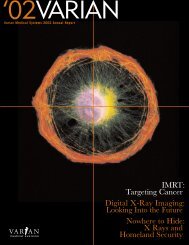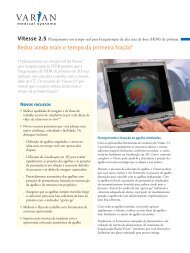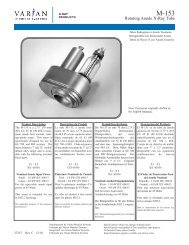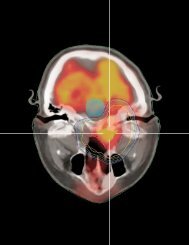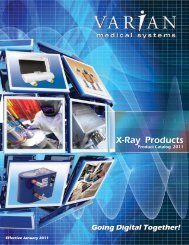4D Integrated Treatment Console 7 - Varian
4D Integrated Treatment Console 7 - Varian
4D Integrated Treatment Console 7 - Varian
Create successful ePaper yourself
Turn your PDF publications into a flip-book with our unique Google optimized e-Paper software.
<strong>4D</strong> <strong>Integrated</strong><br />
<strong>Treatment</strong> <strong>Console</strong><br />
DICOM Conformance Statement<br />
P/N 100016768-03<br />
DECEMBER 2004<br />
V7
General Information<br />
Abstract The <strong>4D</strong> <strong>Integrated</strong> <strong>Treatment</strong> <strong>Console</strong> Version 7, DICOM Conformance Statement (P/N<br />
100016768-03).<br />
and European<br />
Manufacturer<br />
Representative<br />
Manufacturer:<br />
<strong>Varian</strong> Medical Systems, Inc.<br />
3100 Hansen Way, Bldg. 4A<br />
Palo Alto, CA 94304-1030, USA<br />
European Representative:<br />
<strong>Varian</strong> Medical Systems UK Ltd.<br />
Gatwick Road, Crawley<br />
West Sussex RH10 9RG<br />
United Kingdom<br />
Notice Information in this release note is subject to change without notice and does not<br />
represent a commitment on the part of <strong>Varian</strong>. <strong>Varian</strong> is not liable for errors contained in<br />
this user guide or for incidental or consequential damages in connection with furnishing<br />
or use of this material.<br />
FDA 21 CFR 820<br />
Quality System<br />
Regulations<br />
(CGMPs)<br />
ISO 9001 and ISO<br />
13485<br />
This document contains proprietary information protected by copyright. No part of this<br />
document may be reproduced, translated, or transmitted without the express written<br />
permission of <strong>Varian</strong> Medical Systems, Inc.<br />
<strong>Varian</strong> Medical Systems, Oncology Systems products are designed and manufactured<br />
in accordance with the requirements specified within this federal regulation.<br />
<strong>Varian</strong> Medical Systems, Oncology Systems products are designed and manufactured<br />
in accordance with the requirements specified within ISO 9001 and ISO 13485 quality<br />
standards.<br />
CE <strong>Varian</strong> Medical Systems, Oncology Systems products meet the requirements of Council<br />
Directive MDD 93/42/EEC.<br />
Trademarks VARiS is a registered trademark and Vision is trademark of <strong>Varian</strong> Medical Systems,<br />
Inc. Microsoft and Windows are registered trademarks of Microsoft Corporation.<br />
ii <strong>4D</strong>C v7, DICOM Conformance Statement, P/N 100016768-03
Table of Contents<br />
Table of Contents<br />
1. Introduction..........................................................................................................1<br />
1.1 Purpose .....................................................................................................1<br />
1.2 Scope.........................................................................................................1<br />
1.3 Intended Audience .....................................................................................1<br />
1.5 Related Documents ...................................................................................2<br />
2. Implementation Model.........................................................................................3<br />
2.1 Application Data Flow Diagram..................................................................3<br />
2.1.1 Application Data Flow Diagram ......................................................4<br />
2.2 Functional Definition of AE’s ......................................................................6<br />
2.3 Sequencing of Real-World Activities ..........................................................6<br />
3. AE Specifications ................................................................................................9<br />
3.1 <strong>4D</strong>C Entity Specification ............................................................................9<br />
3.1.1 Association Establishment Policies ................................................9<br />
3.1.2 Association Initiation Policy............................................................11<br />
3.1.3 Association Acceptance Policy.....................................................15<br />
4. Privatizations/Extensions/Specializations ......................................................19<br />
4.1 Privatization .............................................................................................19<br />
4.1.1 Privatization for RT Plan Storage SOP class................................19<br />
4.1.2 Privatization for RT Beams Record Storage SOP class ...............20<br />
4.1.3 Privatization for <strong>Treatment</strong> Summary Record Storage SOP class21<br />
4.2 Extensions ...............................................................................................22<br />
4.2.1 RT Plan Extended Interface .........................................................23<br />
4.2.2 <strong>Treatment</strong> Session Extended Interface ........................................25<br />
4.3 Specializations .........................................................................................27<br />
4.3.1 Undefined Values .........................................................................27<br />
4.3.2 Load and Save of Imager Positions..............................................28<br />
4.3.3 RT Image Position vs. Imager Position in “Planned Verification<br />
Image Sequence”.....................................................................................29<br />
5. Communication profiles ...................................................................................31<br />
5.1 Supported communications stacks ..........................................................31<br />
5.1.1 TCP/IP stack ................................................................................31<br />
6. Configuration.....................................................................................................33<br />
6.1 AE Title/Presentation Address Mapping ..................................................33<br />
6.2 Configurable Parameters .........................................................................33<br />
6.2.1 <strong>4D</strong>C Entity ....................................................................................33<br />
7. Support of Extended Character Sets ...............................................................35<br />
Appendix A: IOD Specific Implementation Details .........................................................1<br />
Appendix B: Query/Retrieve .............................................................................................4<br />
B1 Study Root SOP Class Group....................................................................4<br />
<strong>4D</strong>C v7, DICOM Conformance Statement, P/N 100016768-03 iii
List of Figures<br />
List of Figures<br />
Figure 1: SCU Role Application Data Flow Diagram for loading patient data ......................4<br />
Figure 2: SCP Role Application Data Flow Diagram for loading patient data ......................5<br />
Figure 3: SCU Role Application Data Flow Diagram for saving patient data .......................6<br />
Figure 4: Associations used for <strong>4D</strong>C .................................................................................10<br />
iv <strong>4D</strong>C v7, DICOM Conformance Statement, P/N 100016768-03
List of Tables<br />
List of Tables<br />
Table 1: Supported SCU/SCP SOP Classes for <strong>4D</strong>C Entity................................................9<br />
Table 2: Proposed Presentation Contexts for Storage SCU ..............................................11<br />
Table 3: <strong>Treatment</strong> Termination Status .............................................................................13<br />
Table 4: Proposed Presentation Contexts for Query/Retrieve SCU...................................14<br />
Table 5: Acceptable Presentation Contexts for Storage SCP............................................16<br />
Table 6: Image Type..........................................................................................................17<br />
Table 7: RT Plan IOD privatization ....................................................................................19<br />
Table 8: RT Beams Record IOD privatization....................................................................20<br />
Table 9: RT <strong>Treatment</strong> Summary Record IOD privatization ..............................................22<br />
Table 10: RT Plan Extended Interface...............................................................................25<br />
Table 11: <strong>Treatment</strong> Session Extended Interface..............................................................27<br />
Table 12: Tags that allow usage of “undefined value” .......................................................28<br />
Table 13: Supported Query/Retrieve Levels for Query/Retrieve SCU .................................4<br />
Table 14: Study key.............................................................................................................5<br />
Table 15: Series key............................................................................................................5<br />
Table 16: Image key ............................................................................................................6<br />
Table 17: Plan Key ..............................................................................................................6<br />
Table 18: <strong>Treatment</strong> Record key .........................................................................................7<br />
Table 19: <strong>Treatment</strong> Summary Record key .........................................................................8<br />
<strong>4D</strong>C v7, DICOM Conformance Statement, P/N 100016768-03 v
vi <strong>4D</strong>C v7, DICOM Conformance Statement, P/N 100016768-03
1. Introduction<br />
1.1 Purpose<br />
1.2 Scope<br />
Introduction<br />
The definition of the DICOM standard for radiotherapy data started in 1994 and has now<br />
reached a productive state. Today, DICOM is the primary choice for exchanging data with an<br />
open standard protocol for the majority of vendors and institutions. <strong>Varian</strong> Medical Systems<br />
is committed to this notion and supports the full range of radiotherapy objects (e.g. RT Plan,<br />
RT Image, RT <strong>Treatment</strong> Record) for their V & R system.<br />
This conformance statement specifies the conformance of the <strong>4D</strong> <strong>Integrated</strong> <strong>Treatment</strong><br />
<strong>Console</strong> version 7 with the DICOM V 3.0 standard.<br />
The scope and format of this document from chapter 2 onwards are defined by Part 2 of the<br />
DICOM V3.0 standard. Some sections defined in the standard that are not applicable to the<br />
software are left out for clarity.<br />
This Conformance Statement is applicable for <strong>4D</strong> <strong>Console</strong> version 7.<br />
The general DICOM conformance statement for <strong>Varian</strong> Medical Systems products is defined<br />
in [2] (see chapter 1.5). The <strong>4D</strong> <strong>Treatment</strong> <strong>Console</strong> 6.5/7.x Conformance Statement<br />
describes only the specials and the variations as implemented in the <strong>4D</strong> <strong>Console</strong> version 7.<br />
1.3 Intended Audience<br />
• Marketing and Sales.<br />
• System Integrators of medical equipment.<br />
• Other vendors interfacing via DICOM<br />
<strong>4D</strong>C v7, DICOM Conformance Statement, P/N 100016768-03 1 of 36
Introduction<br />
1.4 Definitions<br />
This section provides the definitions of terms, acronyms, and abbreviations, which are used<br />
throughout the document.<br />
AE Application Entity<br />
DICOM Digital Imaging and Communications in Medicine<br />
IOD Information Object Definition<br />
NEMANational Electrical Manufacturers Association<br />
SCU Service Class User<br />
SCP Service Class Provider<br />
SOP Service Object Pair<br />
TCP/IP Transmission Control Protocol / Internet Protocol<br />
VR Value Representation<br />
Multi-Frame Image Image that contains multiple two-dimensional pixel planes<br />
UID Unique Identifier<br />
Management System DICOM entity from which <strong>Treatment</strong> retrieves patient data<br />
<strong>4D</strong>C <strong>4D</strong> <strong>Integrated</strong> <strong>Treatment</strong> <strong>Console</strong> 7.<br />
1.5 Related Documents<br />
[1] Digital Imaging and Communications in Medicine (DICOM), Parts 1-14 (2003),<br />
National Electrical Manufacturers Association (NEMA)<br />
Rosslyn, VA<br />
United States of America<br />
[2] Vision Release 6.5, DICOM Conformance Statement’ (P/N VA7202D3CS)<br />
<strong>Varian</strong> Medical Systems International AG<br />
Baden, Switzerland<br />
2 of 36 <strong>4D</strong>C v7, DICOM Conformance Statement, P/N 100016768-03
2. Implementation Model<br />
2.1 Application Data Flow Diagram<br />
Implementation Model<br />
Three diagrams illustrating the application model, two for the SCU and one for the SCP role,<br />
are shown in Figure 1, Figure 2, and Figure 3.<br />
The initial function to load the plan into the <strong>4D</strong>C application is represented by Load RT Plan<br />
(This function is typically performed by the application after the Patient and the Plan UIDs<br />
have been received by the Management System). <strong>4D</strong>C invokes a move command for each<br />
DICOM RT Plan. This requires the <strong>4D</strong>C application to provide the RT Plan Storage SCP.<br />
Figure 2 shows the Service Class Providers (SCP) role supported by <strong>4D</strong>C. <strong>4D</strong>C then issues<br />
a move command to request and retrieve the RT <strong>Treatment</strong> Summary Record. Based on the<br />
last fraction state, a find command is executed to request the Load Beam Record<br />
Information (shown in Figure 1) to recover from a partial treatment.<br />
A Save issued by the operator will invoke a storage command, which requires the remote<br />
application to provide a storage SCP as shown in Figure 3.<br />
Closing the patient in <strong>4D</strong>C will result in a Save if the plan data has been modified and/or<br />
treatment records and images have been created. <strong>4D</strong>C will delete the objects temporarily<br />
stored. In case the Management System is not accessible, <strong>4D</strong>C will save the changes into<br />
one or several DICOM Media File(s).<br />
<strong>4D</strong>C v7, DICOM Conformance Statement, P/N 100016768-03 3 of 36
Implementation Model<br />
2.1.1 Application Data Flow Diagram<br />
SCU Role SCP Role<br />
Load RT<br />
Plan<br />
Load RT<br />
<strong>Treatment</strong><br />
Summary<br />
Record<br />
Load<br />
Beam<br />
Record<br />
Information<br />
Load RT<br />
Image<br />
<strong>4D</strong>C<br />
DICOM<br />
Standard<br />
Interface<br />
Query/<br />
Retrieve<br />
Move<br />
SCP<br />
Query/<br />
Retrieve<br />
Move<br />
SCP<br />
Query/<br />
Retrieve<br />
Find SCP<br />
Query/<br />
Retrieve<br />
Move<br />
SCP<br />
Figure 1: SCU Role Application Data Flow Diagram for loading patient data<br />
4 of 36 <strong>4D</strong>C v7, DICOM Conformance Statement, P/N 100016768-03
SCP Role SCU Role<br />
Store<br />
Plan<br />
Determine<br />
whether<br />
Beam Record<br />
Information<br />
needs to be<br />
loaded or not<br />
Display<br />
the image<br />
<strong>4D</strong>C<br />
DICOM<br />
Standard<br />
Interface<br />
RT Plan<br />
Storage<br />
SCU<br />
RT<br />
<strong>Treatment</strong><br />
Summary<br />
Record<br />
Storage SCU<br />
RT Image<br />
Storage<br />
SCU<br />
Figure 2: SCP Role Application Data Flow Diagram for loading patient data<br />
Implementation Model<br />
<strong>4D</strong>C v7, DICOM Conformance Statement, P/N 100016768-03 5 of 36
Implementation Model<br />
SCU Role SCP Role<br />
Save RT<br />
Plan<br />
Save RT<br />
Beams<br />
<strong>Treatment</strong><br />
Record<br />
Save RT<br />
Image<br />
6 of 36 <strong>4D</strong>C v7, DICOM Conformance Statement, P/N 100016768-03<br />
<strong>4D</strong>C<br />
DICOM<br />
Standard<br />
Interface<br />
RT Plan<br />
Storage<br />
SCP<br />
RT Beams<br />
<strong>Treatment</strong><br />
Record<br />
Storage<br />
SCP<br />
RT Image<br />
Storage<br />
SCP<br />
Figure 3: SCU Role Application Data Flow Diagram for saving patient data<br />
2.2 Functional Definition of AE’s<br />
The <strong>4D</strong>C Entity’s main responsibility is to execute a patient treatment. Before treating, <strong>4D</strong>C<br />
loads the patient data from the Management System using DICOM services. After treating,<br />
<strong>4D</strong>C generates RT Beams Record(s) and RT Image(s). <strong>4D</strong>C then stores them back to the<br />
Management System again using DICOM services.<br />
<strong>4D</strong>C is also capable of modifying RT Plan(s) and/or creating new RT Plan(s).<br />
2.3 Sequencing of Real-World Activities<br />
<strong>4D</strong>C executes the activities for loading a patient in the following order.<br />
� C-Find RT Plan SOP class (see chapter 3.1.2.2.3.2 )<br />
� C-Move RT Plan SOP class<br />
� C-Move RT <strong>Treatment</strong> Summary Record SOP class
Implementation Model<br />
� C-Find RT Beams Record SOP class if needed (NOTE: The C-Find RT Beams Record<br />
query is only executed in order to finalize the previous treated fraction)<br />
� C-Move RT Image SOP class (for Reference Image(s) if referred in the RT Plan)<br />
� C-Find RT Image SOP class (for query Portal Image(s))<br />
� C-Move RT Image SOP class (for Portal Image(s) if query returned Portal Image<br />
Instance UID(s))<br />
The only requirement is to load the RT Plan first before the others. This sequence may be<br />
performed for more than 1 plan at the beginning of a treatment session.<br />
The following sequence is for saving the patient to <strong>4D</strong>C:<br />
� C-Storage RT Plan SOP class (executed if a plan changed in <strong>4D</strong>C)<br />
� C-Storage RT Beams Record SOP class (executed if a beam got treated)<br />
� C-Storage RT Image SOP class (executed if a Portal Image got acquired)<br />
The only requirement is to save RT Plan(s) first before the RT Beam Record(s) and RT<br />
Image(s). This is because the RT Beams Record and/or RT Image may refer to the new RT<br />
Plan.<br />
<strong>4D</strong>C v7, DICOM Conformance Statement, P/N 100016768-03 7 of 36
8 of 36 <strong>4D</strong>C v7, DICOM Conformance Statement, P/N 100016768-03
3. AE Specifications<br />
3.1 <strong>4D</strong>C Entity Specification<br />
AE Specifications<br />
The <strong>4D</strong>C Entity provides standard conformance to the following DICOM V3.0 SOP classes:<br />
SOP Class Name SCU/SCP Role SOP Class UID<br />
Verification (Echo) SCU / SCP 1.2.840.10008.1.1<br />
RT Image Storage SCU / SCP 1.2.840.10008.5.1.4.1.1.481.1<br />
RT Plan Storage SCU / SCP 1.2.840.10008.5.1.4.1.1.481.5<br />
RT <strong>Treatment</strong> Summary Record<br />
Storage<br />
Study Root Query/Retrieve<br />
information model- FIND<br />
Study Root Query/Retrieve<br />
information model- MOVE<br />
RT Beams <strong>Treatment</strong><br />
Record Storage<br />
SCP 1.2.840.10008.5.1.4.1.1.481.7<br />
SCU 1.2.840.10008.5.1.4.1.2.2.1<br />
SCU 1.2.840.10008.5.1.4.1.2.2.2<br />
SCU 1.2.840.10008.5.1.4.1.1.481.4<br />
Table 1: Supported SCU/SCP SOP Classes for <strong>4D</strong>C Entity<br />
3.1.1 Association Establishment Policies<br />
3.1.1.1 General<br />
See details in [2].<br />
There are a total of three associations. <strong>4D</strong>C establishes two associations while the<br />
Management System establishes one association. The first association established by <strong>4D</strong>C<br />
is to support the C-Move and C-Find services. The second association established by <strong>4D</strong>C<br />
is to support the C-Storage service. The association established by the Management System<br />
is for storing patient data to <strong>4D</strong>C.<br />
All of the association supports the C-Echo service to determine whether the association is<br />
still alive or not.<br />
A diagram of the associations is in Figure 4.<br />
<strong>4D</strong>C v7, DICOM Conformance Statement, P/N 100016768-03 9 of 36
AE Specifications<br />
<strong>Treatment</strong><br />
C-Find/Move<br />
C-Echo<br />
Figure 4: Associations used for <strong>4D</strong>C<br />
3.1.1.2 Number of Associations<br />
In total, there are three associations established (Figure 4).<br />
3.1.1.3 Asynchronous Nature<br />
C-Storage RT Plan<br />
C-Storage RT Image<br />
C-Storage RT <strong>Treatment</strong><br />
Summary Record<br />
C-Echo<br />
C-Storage RT Plan<br />
C-Storage RT Beams<br />
<strong>Treatment</strong> Record<br />
C-Storage RT Image<br />
C-Echo<br />
Asynchronous operation is not supported.<br />
3.1.1.4 Implementation Identifying information<br />
The following implementation class UIDs are used:<br />
Application Entity Implementation UID<br />
<strong>4D</strong>C Entity SCU 1.2.246.352.70.2.1.9<br />
<strong>4D</strong>C Entity SCP 1.2.246.352.70.2.1.10<br />
10 of 36 <strong>4D</strong>C v7, DICOM Conformance Statement, P/N 100016768-03<br />
Management System<br />
Association
3.1.2 Association Initiation Policy<br />
AE Specifications<br />
The <strong>4D</strong>C Entity will initiate one association for all Query/Retrieve Services (Q/R SCU) that<br />
contains the C-Find and the C-Move service.<br />
The <strong>4D</strong>C Entity will initiate one association for all Storage Services where it acts as a user<br />
(Storage SCU).<br />
The Management System will initiate one association for all C-Storage services used for<br />
sending all patient data. In this association, <strong>4D</strong>C acts as a provider (Storage SCP).<br />
For performance reasons, <strong>4D</strong>C maintains its associations until one of the following occurs:<br />
i) <strong>4D</strong>C is terminated (this results with all associations being terminated)<br />
or<br />
2) the Echo/Verification service fails (this results with the Echo/Verification’s<br />
corresponding association to be terminated)<br />
3.1.2.1 Storage SCU<br />
3.1.2.1.1 Associated Real-World Activity<br />
The C-Storage service is used in <strong>4D</strong>C to store patient data into the Management System.<br />
This service gets executed whenever the operator selects ‘Close Patient’ or ‘Save Image’.<br />
3.1.2.1.2 Presentation Context Table<br />
RT Plan<br />
Storage<br />
Presentation Context Table<br />
Abstract Syntax Transfer Syntax Role Extended<br />
Negotiation<br />
Name UID Name UID<br />
RT Beams<br />
<strong>Treatment</strong><br />
Record<br />
Storage<br />
RT Image<br />
Storage<br />
1.2.840.10008.5.1.4.1.1.481.5 DICOM Implicit<br />
VR Little Endian<br />
1.2.840.10008.5.1.4.1.1.481.4 DICOM Implicit<br />
VR Little Endian<br />
1.2.840.10008.5.1.4.1.1.481.1 DICOM Implicit<br />
VR Little Endian<br />
Table 2: Proposed Presentation Contexts for Storage SCU<br />
1.2.840.10008.1.2 SCU None<br />
1.2.840.10008.1.2 SCU None<br />
1.2.840.10008.1.2 SCU None<br />
<strong>4D</strong>C v7, DICOM Conformance Statement, P/N 100016768-03 11 of 36
AE Specifications<br />
3.1.2.1.3 SOP Specific Conformance<br />
3.1.2.1.3.1 SOP specific conformance for all Storage SOP classes<br />
After a successful C-STORE operation, <strong>4D</strong>C does not display any information to the user but<br />
returns to its normal state. If the C-STORE operation results with a warning or an error, <strong>4D</strong>C<br />
displays the appropriate warning or error message to the operator.<br />
3.1.2.1.3.2 SOP specific conformance for the RT Plan Storage SOP class<br />
The following SOP specific conformance rules apply to <strong>4D</strong>C:<br />
Bolus is not supported.<br />
Setup Fields are supported. (Note: The Field Type attribute defines whether it is a Setup<br />
field or a <strong>Treatment</strong> field (see Table 10))<br />
<strong>4D</strong>C does not accept Arc-Dynamic Beam(s), which contain gantry rotations that is not<br />
equally spaced (e.g. 0, 10, 30, 100).<br />
Only the first Fraction Group sequence (300A, 0070) is read. The others are discarded.<br />
A maximum of two wedges per field are supported.<br />
A maximum of one MLC per field is supported.<br />
Beam energy, table parameter and rotation direction changes in the control points are not<br />
supported.<br />
Wedge position changes are only supported for static technique (motorized wedge).<br />
Whenever an operator changes a dose relevant attribute from the RT Plan in <strong>4D</strong>C, a new RT<br />
Plan is created. The new RT Plan will refer to the originally loaded RT Plan through the<br />
Referenced RT Plan Sequence (300C,0002). The Referenced RT Plan Sequence<br />
(300C,0002) can only contain at most one item.<br />
RT Plan extended interface and privatization is described in chapter 4.<br />
3.1.2.1.3.3 SOP specific conformance for the RT Beams <strong>Treatment</strong> Record storage SOP class<br />
Beam Limiting Device Position Sequence (300A,011A) only contains collimator jaws<br />
positions. It does not contain any MLC leaf position information. MLC leaf positions will not<br />
be reported within the RT Beams <strong>Treatment</strong> Record IOD. Beams with <strong>Treatment</strong> Delivery<br />
Type (300A,00CE) set to OPEN_PORTFILM or TRMT_PORTFILM are Image Beams.<br />
Beams with <strong>Treatment</strong> Delivery Type set to TREATMENT are <strong>Treatment</strong> Beams. All Image<br />
Beams refers to a <strong>Treatment</strong> Beam through the attribute Related Beam Number defined in<br />
chapter 4.1.2. If MU Subtraction is set for an Image Beam, the treated MU count will be<br />
deducted from the related <strong>Treatment</strong> Beam. For <strong>Treatment</strong> Beams, MU Subtraction is<br />
always set. The <strong>Treatment</strong> Termination Status (3008,002A) specifies whether the treatment<br />
was completed or partially completed. The following attributes are used to determine<br />
whether the MU Subtraction is set or not set:<br />
12 of 36 <strong>4D</strong>C v7, DICOM Conformance Statement, P/N 100016768-03
<strong>Treatment</strong> Delivery<br />
Type (300A,00CE)<br />
Related<br />
Beam<br />
Number (*)<br />
<strong>Treatment</strong><br />
Termination Status<br />
(3008, 002A)<br />
OPEN_PORTFILM<br />
TRMT_PORTFILM<br />
set MACHINE set<br />
OPEN_PORTFILM<br />
TRMT_PORTFILM<br />
set NORMAL not set<br />
TREATMENT not set According remaining<br />
MU<br />
set<br />
Table 3: <strong>Treatment</strong> Termination Status<br />
MU Subtraction<br />
AE Specifications<br />
(*) Related Beam Number is a private tag added to the RT Beams Session Record module<br />
(see chapter 4.1.2)<br />
RT Beams <strong>Treatment</strong> Record Extended Interface and privatization is described in chapter 4.<br />
3.1.2.1.3.4 SOP specific conformance for the RT Image Storage SOP class<br />
The <strong>4D</strong>C Entity only stores images with the Image Type (0008,0008) set to PORTAL.<br />
3.1.2.2 Query/Retrieve SCU<br />
3.1.2.2.1 Associated Real-World Activity<br />
<strong>4D</strong>C uses the Query/Retrieve information model MOVE for retrieving patient data from the<br />
Management System. After a successful query, the Management System sends the<br />
requested data with the C-Store service.<br />
<strong>4D</strong>C uses the Query/Retrieve information model FIND for gathering information from the<br />
Management System. In order to determine whether a Beam was partially treated or<br />
completed, <strong>4D</strong>C queries for several attributes in the RT Beams Record stored in the<br />
management.<br />
<strong>4D</strong>C v7, DICOM Conformance Statement, P/N 100016768-03 13 of 36
AE Specifications<br />
3.1.2.2.2 Presentation Context Table<br />
Presentation Context Table<br />
Abstract Syntax Transfer Syntax Role Extended<br />
Negotiation<br />
Name UID Name UID<br />
Study Root<br />
Query/<br />
Retrieve<br />
Information<br />
Model -<br />
FIND<br />
Study Root<br />
Query/<br />
Retrieve<br />
Information<br />
Model -<br />
MOVE<br />
1.2.840.10008.5.1.4.1.2.2<br />
.1<br />
1.2.840.10008.5.1.4.1.2.2<br />
.2<br />
DICOM Implicit<br />
VR Little Endian<br />
DICOM Implicit<br />
VR Little Endian<br />
1.2.840.10008.1.2 SCU None<br />
1.2.840.10008.1.2 SCU None<br />
Table 4: Proposed Presentation Contexts for Query/Retrieve SCU<br />
3.1.2.2.3 SOP Specific Conformance<br />
For all C-Move SOP classes, the query key is always the SOP Instance UID of the particular<br />
DICOM IOD that <strong>4D</strong>C requests. There are no other matching criteria’s for the C-Move key.<br />
All keys used for the C-Move service are defined in 4 and B 1.1.<br />
The following Query/Retrieve SOP are used by <strong>4D</strong>C as a Service Class User (SCU):<br />
� C-Move RT Plan<br />
� C-Move RT <strong>Treatment</strong> Summary Record<br />
� C-Move RT Image<br />
� C-Find RT Beams <strong>Treatment</strong> Record<br />
� C-Find RT Plan<br />
� C-Find RT Image<br />
The C-Move service requires <strong>4D</strong>C to be an SCP of the C-Storage service for the same<br />
DICOM IOD. For example whenever <strong>4D</strong>C is a SCU of C-Move RT Plan it implies that <strong>4D</strong>C is<br />
a SCP of C-Storage RT Plan (see Table 1).<br />
14 of 36 <strong>4D</strong>C v7, DICOM Conformance Statement, P/N 100016768-03
AE Specifications<br />
3.1.2.2.3.1 SOP specific conformance for the C–Find RT Beams <strong>Treatment</strong> Record SOP class<br />
The C-Find RT Beams <strong>Treatment</strong> Record SOP class will be used for calculating the<br />
remaining MU. The remaining monitor units are calculated with the Beam Meterset<br />
(300A,0086) in the RT Fraction Scheme module (provided from the Plan IOD) minus the<br />
Delivered Primary Meterset (3008, 0036) (provided from the Beam Record Information) -see<br />
Table 18). If the monitor units were overridden, the Beam Record Information contains the<br />
overridden value Specified Meterset (3008, 0042). In this case, the overridden Specified<br />
Meterset (3008, 0042) is used instead of the Beam Meterset (300A,0086) to calculate the<br />
remaining monitor units.<br />
The <strong>Treatment</strong> History key contains the matching criteria for the RT Beams <strong>Treatment</strong><br />
Record. Whenever the key matches the particular RT Beams <strong>Treatment</strong> Record, the<br />
attributes defined in Table 18 (SCP column) gets filled in. Note that the <strong>Treatment</strong> Session<br />
Beam Sequence may contain one or more item. It is up to the Managment System to decide<br />
whether for each <strong>Treatment</strong> Session Beam one <strong>Treatment</strong> History key gets send or if all<br />
<strong>Treatment</strong> Session Beam are send within one <strong>Treatment</strong> History key.<br />
Only the last treated fraction is the fraction of interest.<br />
3.1.2.2.3.2 SOP specific conformance for the C – Find RT Plan SOP class<br />
Plans may be loaded into <strong>4D</strong>C without having them scheduled for the current session.<br />
Therefore <strong>4D</strong>C has to know how many treatment plans a patient has. This information gets<br />
retrieved with the C – Find RT Plan SOP Class. The Plan key contains the matching criteria<br />
and the placeholder for all attributes. The Plan key is defined in Table 17. The SOP Instance<br />
UID defined in the Plan key is the Plan Instance UID which will be used to load an<br />
unscheduled Plan in <strong>4D</strong>C.<br />
3.1.2.2.3.3 SOP specific conformance for the C – Find RT Image SOP class<br />
Since Portal Images are not referenced within the RT Plan, <strong>4D</strong>C queries the Portal Images<br />
from the Management System with the C – Find RT Image service SOP class. The Image<br />
key is defined in Table 16. The Referenced SOP Instance UID (i.e. the Plan Instance UID)<br />
and the Referenced Beam Number uniquely identifies the Beam, which <strong>4D</strong>C needs to query<br />
the Portal Images from. <strong>4D</strong>C uses the SOP Instance UID (i.e. the RT Image Instance UID )<br />
to retrieve previous acquired Portal Image. The C – Find confirmation returns as many<br />
Image keys as Portal Images stored in the Management System for that particular beam.<br />
3.1.3 Association Acceptance Policy<br />
The <strong>4D</strong>C Entity accepts all association requests that request one of the supported service<br />
classes. <strong>4D</strong>C accepts only one Management System Application Entity for the three possible<br />
associations (see Figure 4).<br />
<strong>4D</strong>C v7, DICOM Conformance Statement, P/N 100016768-03 15 of 36
AE Specifications<br />
3.1.3.1 Storage SCP<br />
3.1.3.1.1 Associated Real-World Activity<br />
The patient data gets retrieved through the C- Storage service. This service is the only one<br />
that gets supported from <strong>4D</strong>C as an SCP.<br />
3.1.3.1.2 Presentation Context Table<br />
Abstract Syntax<br />
Presentation Context Table<br />
Transfer Syntax Role Extended<br />
Negotiation<br />
Name UID Name UID<br />
Verification 1.2.840.10008.1.1<br />
DICOM Implicit<br />
VR Little Endian<br />
1.2.840.10008.1.2 SCP None<br />
DICOM Explicit<br />
VR Little Endian<br />
1.2.840.10008.1.2.1 SCP None<br />
RT Plan 1.2.840.10008.5.1.4.1.1.481.5 DICOM Implicit 1.2.840.10008.1.2 SCP None<br />
Storage<br />
VR Little Endian<br />
DICOM Explicit 1.2.840.10008.1.2.1 SCP None<br />
RT Plan<br />
Storage<br />
RT<br />
<strong>Treatment</strong><br />
Summary<br />
Record<br />
Storage<br />
1.2.840.10008.5.1.4.1.1.481.5<br />
1.2.840.10008.5.1.4.1.1.481.7<br />
VR Little Endian<br />
DICOM Implicit<br />
VR Little Endian<br />
DICOM Explicit<br />
VR Little Endian<br />
DICOM Implicit<br />
VR Little Endian<br />
DICOM Explicit<br />
VR Little Endian<br />
Table 5: Acceptable Presentation Contexts for Storage SCP<br />
3.1.3.1.3 SOP Specific Conformance<br />
3.1.3.1.3.1 SOP specific conformance for the Storage SOP class<br />
1.2.840.10008.1.2 SCP None<br />
1.2.840.10008.1.2.1 SCP None<br />
1.2.840.10008.1.2 SCP None<br />
1.2.840.10008.1.2.1 SCP None<br />
<strong>4D</strong>C is not an archive system. Thus DICOM IOD’s are temporarily stored during a treatment<br />
session and deleted once the session is finished.<br />
3.1.3.1.3.2 SOP specific conformance for RT Image Storage SOP class<br />
The <strong>4D</strong>C Entity supports the image types DRR, PORTAL, and SIMULATOR.<br />
To represent portal dose, RT Images of image type PORTAL are used. This is based on<br />
DICOM standard Part 3, section A.17.3 (RT Image IOD Module Table), Notes 2. The<br />
conversion between portal image pixel values and portal dose is defined by the Modality<br />
LUT module through re-scale Slope and Intercept. The unit depends on the re-scale Type.<br />
The image type in Table 6 distinguishes the two types of portal doses:<br />
16 of 36 <strong>4D</strong>C v7, DICOM Conformance Statement, P/N 100016768-03
Image Type Meaning<br />
DERIVED\SECONDARY\PORTAL\CALCULAT<br />
ED_DOSE<br />
ORIGINAL\PRIMARY\PORTAL\ACQUIRED_D<br />
OSE<br />
Table 6: Image Type<br />
RT Image Geometrical Values<br />
AE Specifications<br />
Portal dose predicted by a treatment planning<br />
system, i.e. an estimate of the dose that will be<br />
perceived by the portal imaging device.<br />
Portal dose actually measured by the portal<br />
imaging device based on its calibration.<br />
RT Images (used as reference images) require a sufficient amount of geometrical<br />
parameters that will define the position of RT Images with respect to the machine. The<br />
following parameters are required for proper operation of image verification applications<br />
associated with <strong>4D</strong>C:<br />
X-Ray Image Receptor Translation (3002,000D)<br />
Value must be present.<br />
X-Ray Image Receptor Angle (3002,000E)<br />
Value must be present.<br />
Note: In the current release, only 0 is supported. Providing this value will ensure safe<br />
interpretation.<br />
RT Image Position (3002,0012)<br />
It is recommended to have this value defined. If the value is not defined, the<br />
application will assume that the image was centered on the X-Ray Image Receptor<br />
System.<br />
Radiation Machine SAD (3002,0022) or RT Image SID (3002,0026)<br />
At least one of the two values must be present.<br />
Image Plane Pixel Spacing (3002,0011)<br />
Value must be present.<br />
Gantry Angle (300A,011E)<br />
Value must be present. This value shall represent the angle (in IEC GANTRY system<br />
coordinates) where the physical or virtual (in case of DRR) source of radiation is<br />
located.<br />
Note: When kV images are used as Reference Images, this value describes the<br />
projection geometry. Therefore, this value may not coincide with the Gantry Hardware<br />
Readout of the linear accelerator since the kV Image radiation source may be on a<br />
different position than the linear accelerator’s target focus.<br />
RT Orientation (3002,0010)<br />
In the future, it is recommended to have this value defined for images that have the RT<br />
Image Plane set to NORMAL (this value is required for NON-NORMAL images). This<br />
is because the DICOM standard does not unambiguously define the position of the RT<br />
Image pixel area in the IEC Image Receptor system when this value is missing. If this<br />
value is not provided, the application assumes that the value is (1,0,0,0,-1,0).<br />
<strong>4D</strong>C v7, DICOM Conformance Statement, P/N 100016768-03 17 of 36
AE Specifications<br />
3.1.3.1.3.3 SOP specific conformance for the RT Plan Storage SOP class<br />
<strong>4D</strong>C will only accept the Beam Limiting Device if the verification of the treatment machine<br />
settings and the Beam Limiting Device were successful. The same rule applies to the<br />
imported Wedge, Block and Applicator data.<br />
The following SOP specific conformance rules apply to <strong>4D</strong>C:<br />
Bolus is not supported.<br />
Setup Fields are supported. (Note: The Field Type attribute defines whether it is a Setup<br />
field or a <strong>Treatment</strong> field (see Table 10))<br />
<strong>4D</strong>C does not accept Arc-Dynamic Beam(s), which contain gantry rotations that is not<br />
equally spaced (e.g. 0, 10, 30, 100).<br />
Only the first Fraction Group sequence (300A, 0070) is read. The others are discarded.<br />
A maximum of two wedges per field are supported.<br />
A maximum of one MLC per field is supported.<br />
Beam energy, table parameter and rotation direction changes in the control points are not<br />
supported.<br />
Wedge position changes are only supported for static technique (motorized wedge).<br />
RT Plan extended interface and privatization is described in chapter 4.<br />
3.1.3.1.3.4 SOP specific conformance for the RT <strong>Treatment</strong> Summary Record SOP class<br />
RT <strong>Treatment</strong> Summary Record IOD contains additional private tags defined in chapter4.1.3.<br />
3.1.3.2. Presentation Context Acceptance Criterion<br />
The <strong>4D</strong>C Entity will accept the presentation contexts listed in Table 4: Proposed<br />
Presentation Contexts for Query/Retrieve SCU.<br />
3.1.3.3 Transfer Syntax Selection Policies<br />
The <strong>4D</strong>C Entity will accept the DICOM default transfer syntax (implicit VR Little Endian) for<br />
all SOP’s. The <strong>4D</strong>C Entity supports explicit VR Little Endian only for the SCP role.<br />
18 of 36 <strong>4D</strong>C v7, DICOM Conformance Statement, P/N 100016768-03
4. Privatizations/Extensions/Specializations<br />
4.1 Privatization<br />
4.1.1 Privatization for RT Plan Storage SOP class<br />
DICOM Extended Interface is a private module added to the RT Plan IOD. This module<br />
contains an XML stream that contains the Plan Extended Interface described in chapter<br />
4.2.1.<br />
Module Tag Description Type VR<br />
DICOM<br />
Extended Interface Data XML stream. 3 IS<br />
Extended<br />
Interface<br />
(3253,1000)<br />
DICOM<br />
Extended Interface Length Data length of the XML stream 3 IS<br />
Extended<br />
Interface<br />
(3253,1001)<br />
DICOM<br />
Extended<br />
Interface<br />
Extended Interface Format<br />
(3253,1002)<br />
Extended Interface Format tag 3<br />
Possible value is: ‘ExtendedIF’<br />
IS<br />
RT Beam/Beam >Beam Secondary Name User-defined secondary name for 3 LO<br />
Sequence (3243,1009)<br />
Beam.<br />
RT Beam/Beam<br />
Sequence/Plann<br />
ed Verification<br />
Image Sequence<br />
RT Fraction<br />
Scheme/Fraction<br />
Group<br />
Sequence/Refere<br />
nced Beam<br />
Sequence<br />
>>Imaging Device-Specific<br />
Acquisition Parameters<br />
(300A,00CC)<br />
>>Maximum <strong>Treatment</strong> Time<br />
(3249,1000)<br />
Table 7: RT Plan IOD privatization<br />
Type/quality used to acquire<br />
verification image.<br />
The following values are used:<br />
PortImageHighQuality<br />
Single port image optimized for<br />
image quality.<br />
PortImageLowDose<br />
Single port image optimized for low<br />
dose.<br />
PortImageContinuous<br />
Multiple port images acquired at<br />
highest possible rate. (300C,0008)<br />
must be 0.<br />
PortImage<strong>Integrated</strong><br />
<strong>Integrated</strong> port image with frames<br />
averaged during the entire beam on<br />
time.<br />
Default Imaging Parameters (*)<br />
Indicates that there is no during<br />
image planned and that the imager<br />
positions specified apply to the<br />
existing Before Image and/or After<br />
Image Beam(s).<br />
The maximum treatment time, which<br />
should not be exceeeded. This items<br />
serves as a secondary safety limit<br />
besides the Beam Meterset value<br />
(300A,0086) itself. Units in [min].<br />
3 DS<br />
<strong>4D</strong>C v7, DICOM Conformance Statement, P/N 100016768-03 19 of 36
Privatization and Extensions<br />
(*) The IT Daemon stores <strong>Treatment</strong> Field data (which includes the During Image Beam) but<br />
does not store Before Image Beam and After Image Beam data. In the case where there are<br />
Before Image and/or After Image Beam(s) along with a During Image Beam, since the<br />
imager positions of the Before Image and/or After Image Beam(s) are always set equal to<br />
the During Image data, changes to the imager positions of the Before Image and After Image<br />
Beam(s) are stored in the During Beam and thus stored in IT Daemon. However, in the case<br />
where there are Before Image and/or After Image Beam(s) without a During Image Beam,<br />
changes to the Before Image and After Image Beam(s) are lost on the next retrieve from IT<br />
Daemon. To resolve this problem, the Default Imaging Parameters value was introduced.<br />
Setting Imaging Device-Specific Acquisition Parameters to Default Imaging Parameters<br />
indicates that there is no During Image Beam planned but that the imager positions<br />
contained in the <strong>Treatment</strong> Field apply to the existing Before Image and/or After Image<br />
Beam(s). The introduction of the Default Imaging Parameters value allowed imager position<br />
values of the Before Image and/or After Image Beam(s) to be stored in the <strong>Treatment</strong> Field<br />
without a During Image Beam having to be present.<br />
4.1.2 Privatization for RT Beams Record Storage SOP class<br />
Module Tag Description Type VR<br />
RT Beam Session ><strong>Treatment</strong> Machine Note A textual description of the treatment 3 LO<br />
Record/<strong>Treatment</strong><br />
Session Beam<br />
Sequence<br />
(3251, 1000)<br />
machine details<br />
RT Beam Session ><strong>Treatment</strong> Session Beam Extended interface in XML format 3 OB<br />
Record/<strong>Treatment</strong> Data<br />
(see Error! Reference source not<br />
Session Beam<br />
Sequence<br />
(3261,102A)<br />
found.).<br />
RT Beam Session >Related Referenced Beam If <strong>Treatment</strong>DeliveryType of the 3 IS<br />
Record/<strong>Treatment</strong> Number<br />
treated beam is either<br />
Session Beam (3243,1026)<br />
OPEN_PORTFILM or<br />
TRMT_PORTFILM then the Related<br />
Referenced Beam Number must be<br />
must be used instead of the<br />
Referenced Beam Number (300C,<br />
0006). The Related Referenced<br />
Beam Number refers to the<br />
treatment field for which the image<br />
got taken.<br />
Table 8: RT Beams Record IOD privatization<br />
The Extended Interface for the RT Beams Record IOD is described in chapter 4.2.2.<br />
20 of 36 <strong>4D</strong>C v7, DICOM Conformance Statement, P/N 100016768-03
Privatization and Extensions<br />
4.1.3 Privatization for <strong>Treatment</strong> Summary Record Storage SOP class<br />
Module Tag Description Type VR<br />
RT <strong>Treatment</strong> Additional Dose Value Introduces sequence of Actual 3 SQ<br />
Summary Record Sequence<br />
Session Dose Sequence. The<br />
(3259,1000)<br />
sequence may contain one or more<br />
items.<br />
Sequence for additional Dose<br />
Information to a Reference Point.<br />
The ReferencePoint must be<br />
connected to Referenced Plan of<br />
this <strong>Treatment</strong>Summary Record, but<br />
also the Dose of other Plans which<br />
have the same Reference Point<br />
have influence on this values.<br />
RT <strong>Treatment</strong> >Actual Session Dose Session Dose Delivered of Actual 1C DS<br />
Summary (3259,1002)<br />
Session<br />
Record/<br />
Required if Actual Session Dose<br />
Additional Dose<br />
Value Sequence<br />
Sequence is sent.<br />
RT <strong>Treatment</strong> >Daily Dose<br />
Daily Dose of current day.<br />
1C DS<br />
Summary (3259,1004)<br />
Required if Actual Session Dose<br />
Record/<br />
Additional Dose<br />
Value Sequence<br />
Sequence is sent.<br />
RT <strong>Treatment</strong> >Life Time Total Dose Total Dose of Reference Point over 2C DS<br />
Summary (3259,1006)<br />
all Plans.<br />
Record/<br />
Required if Actual Session Dose<br />
Additional Dose<br />
Value Sequence<br />
Sequence is sent.<br />
RT <strong>Treatment</strong> Total Number of Fractions<br />
Summary Record (3265,1000)<br />
Total number of Fractions<br />
planned for the current plan and<br />
all its former plans.<br />
1C SL<br />
<strong>4D</strong>C v7, DICOM Conformance Statement, P/N 100016768-03 21 of 36
Privatization and Extensions<br />
RT <strong>Treatment</strong><br />
Summary Record<br />
Last Treated Fraction<br />
(3265,1001)<br />
The index of the last<br />
fraction treated across<br />
the current plan and all<br />
its former plans. In<br />
other words: This tag<br />
will always contain the<br />
fraction, which was last<br />
treated (completely or<br />
partially). So it will be<br />
the same as in the<br />
Fraction Status<br />
Summary Sequence<br />
(3008,0240) on the last<br />
item of the sequence in<br />
the tag Referenced<br />
Fraction Number<br />
(3008,0223), as soon<br />
as the sequence is not<br />
empty any more (so<br />
after the 1st treatment<br />
has got at least 1 MU).<br />
In case of completing a partial<br />
treatment, the plan’s current fraction<br />
number is equal to Last Treated<br />
Fraction (3265, 1001).<br />
Table 9: RT <strong>Treatment</strong> Summary Record IOD privatization<br />
4.2 Extensions<br />
1C SL<br />
This chapter describes the items not available through standard DICOM. The Extended<br />
Interface for RT Plan is supported through an additional module that gets added to the RT<br />
Plan IOD (see a4.1.1). The Extended Interface for RT Beams Record is supported through a<br />
private attribute in the <strong>Treatment</strong> Session Beam (see 4.1.2).<br />
It should be noted that <strong>4D</strong>C was designed to work without the extended interface. Therefore<br />
the following rules apply:<br />
� <strong>4D</strong>C shall not rely on the extended interface for the base functionality. It is possible<br />
to operate without RT Plan Extended interface and <strong>Treatment</strong> Session Extended<br />
Interface.<br />
� Under no circumstances should data be presented in both Extended Interfaces and<br />
the standard DICOM definition.<br />
22 of 36 <strong>4D</strong>C v7, DICOM Conformance Statement, P/N 100016768-03
4.2.1 RT Plan Extended Interface<br />
Privatization and Extensions<br />
The RT Plan Extended Interface is contained in the DICOM Extended Interface module.<br />
Table 10 describes the extended interface. Node names with an empty data type attributes<br />
are parent XML nodes. The XML values are all text (not attributes). The data type defines<br />
which type the XML text has to be converted to.<br />
Node Name min Max Data Node Description<br />
occurs occurs Type<br />
ExtendedVAPlanInterface 0 1<br />
> Beams 0 1<br />
>> Beam 0 Unbou<br />
nded<br />
>>> ReferencedBeamNumber 1 1 int Beam identifier<br />
>>> BeamExtension 1 1 Additional items<br />
provided from Vision to<br />
expand the features of<br />
RT Beams.<br />
>>>> FieldType 1 1 string TREATMENT or SETUP<br />
>>>> RelatedTreatBeamNumber 0 1 int Relation from the image<br />
beams to the treatment<br />
and/or setup beams.<br />
>>>> FieldOrder 1 1 int Order in which the fields<br />
are shown<br />
>>>> GantryRtnExtendedStart 0 1 string When ‘true’, gantry<br />
angle position is in the<br />
extended range, which<br />
means it has an over<br />
travel (a Gantry can<br />
move most typical 400'<br />
and not only 360').<br />
>>>> GantryRtnExtendedStop 0 1 string When’ true’, gantry<br />
angle position is in the<br />
extended range, which<br />
means it has an over<br />
travel (a Gantry can<br />
move most typical 400'<br />
and not only 360').<br />
>>>> MUSubtraction 0 1 string MUSubtraction defines<br />
whether some MUs have<br />
to be subtracted from<br />
the related treatment<br />
beam to take images in<br />
the before phase and/or<br />
after phase. The string<br />
contains “true” or “false”.<br />
>>>> FieldSetupPhotos 0 1<br />
>>>>> FieldSetupPhoto 0 2 Two setup photos max<br />
>>>>>> SetupPhotoNumber 1 1 int Increasing number of<br />
setup photos. The value<br />
has to start from 1 and<br />
up.<br />
>>>>>> SetupPhotoFormat 1 1 string The format of the pixel<br />
information. Supported<br />
values are 'JPG' and<br />
'BMP'<br />
<strong>4D</strong>C v7, DICOM Conformance Statement, P/N 100016768-03 23 of 36
Privatization and Extensions<br />
>>>>>> SetupPhotoPicture 1 1 hex<br />
binary<br />
Pixel information of the<br />
photo in the<br />
corresponding format.<br />
>>>>>> PhotoModified 1 1 string Photo has been<br />
modified.<br />
PhotoModified may have<br />
‘true’ or ‘false’<br />
>>> CustomAddOns 0 1<br />
>>>> CustomAddOn 0 4<br />
>>>>> CustomAddOnType 1 1 string Three Add On Type to<br />
choose from:<br />
BLOCK<br />
COMPENSATOR<br />
TRAY<br />
>>>>> CustomCode 0 1 int Codes for accessory<br />
which may be custom<br />
made or factory made<br />
(in that case the internal<br />
code in equal the<br />
custom code.)<br />
>>>>> ReferencedAddOnNumber 0 1 int Reference to the<br />
identification number of<br />
the Block or<br />
Compensator.<br />
>>>>> TraySpecification 0 1 In case the<br />
CustomAddOn is a tray,<br />
it gets reported back<br />
through this node<br />
>>>>>> TrayID 1 1 string User-supplied identifier<br />
for tray. Max length is 16<br />
characters.<br />
>>>>>> SourceTrayDistance 0 1 int The distance from<br />
source to slot. This<br />
information is needed to<br />
distinguish the slot<br />
> ToleranceTables 0 1<br />
>> ToleranceTable 0 Unbou<br />
nded<br />
>>><br />
ReferencedToleranceTableNumb<br />
er<br />
Additional items<br />
provided from Vision to<br />
expand the features of<br />
Tolerance Tables with<br />
AutoSetup capabilities<br />
1 1 int Refers to the tolerance<br />
table in RT Tolerance<br />
Table module<br />
>>> ToleranceTableExtension 1 1<br />
>>>> GantryRtnSetup 0 1 string Setup attributes may<br />
have following type:<br />
Automatic<br />
Manual<br />
Remote<br />
>>>> CollRtnSetup 0 1 string<br />
>>>> CollXSetup 0 1 string<br />
>>>> CollYSetup 0 1 string<br />
>>>> PatientSupportAngleSetup 0 1 string<br />
>>>> CouchLngSetup 0 1 string<br />
>>>> CouchVrtSetup 0 1 string<br />
>>>> CouchLatSetup 0 1 string<br />
24 of 36 <strong>4D</strong>C v7, DICOM Conformance Statement, P/N 100016768-03
Privatization and Extensions<br />
>>>><br />
TableTopEccentricAngleSetup<br />
0 1 string<br />
> DoseReferences 0 1<br />
>> DoseReference 0 Unbou<br />
nded<br />
>>><br />
1 1 int Reference to the<br />
ReferencedDoseReferenceNumb<br />
identification number of<br />
er<br />
the Dose Reference<br />
(300A,0012) in the RT<br />
Prescription module<br />
which is a representation<br />
of our reference point<br />
>>> DoseReferenceExtension 1 1 Additional items<br />
provided from Vision to<br />
expand the features of<br />
reference points.<br />
>>>> DailyDoseLimit 0 1 decimal Unit is [Gy]<br />
>>>> SessionDoseLimit 0 1 decimal Unit is [Gy]<br />
>>>> Breakpoints 0 1<br />
>>>>> Breakpoint 0 Unbou<br />
Breakpoint extensions.<br />
nded<br />
Standard DICOM does<br />
not support Breakpoints.<br />
>>>>>> BreakpointDose 1 1 decimal Unit is [Gy]<br />
>>>>>> BreakpointWarning 1 1 string Text which describes the<br />
breakpoint. Max length<br />
is 254 characters<br />
Table 10: RT Plan Extended Interface<br />
4.2.2 <strong>Treatment</strong> Session Extended Interface<br />
<strong>Treatment</strong> Session Beam contains a private attribute that contains the Extended Interface as<br />
an XML stream.<br />
Node names with an empty data type attributes are parent XML nodes. The XML values are<br />
all text (not attributes). The data type defines which type the XML text has to be converted<br />
to.<br />
Node Name min Max Data Node Description<br />
occurs occurs Type<br />
RTBeamSessionRecordExtended<br />
IF<br />
0 1<br />
> DoseOverrides 0 1<br />
>> DoseOverride 0 Unbou<br />
There may be as many<br />
nd<br />
DoseOverride nodes as<br />
Reference Points.<br />
>>> DoseOverrideType 1 1 string Type of dose overrides.<br />
Supported are:<br />
BREAKPOINT:<br />
Breakpoint dose limit<br />
overridden<br />
DAILYDOSE: Daily dose<br />
limit overridden<br />
SESSIONDOSE:<br />
Session dose limit<br />
overridden<br />
<strong>4D</strong>C v7, DICOM Conformance Statement, P/N 100016768-03 25 of 36
Privatization and Extensions<br />
TOTALDOSE:<br />
>>> Dose 0 1 decimal Contains the specific<br />
overridden/authorized<br />
dose for<br />
DoseOverrideType<br />
‘BREAKPOINT’ at<br />
the Reference Point<br />
referenced by Dose<br />
Reference Number.<br />
>>> DoseReferenceNumber 1 1 nonNeg<br />
ativeInt<br />
eger<br />
Unit is [Gy]<br />
References the<br />
Reference Point on<br />
which the dose was<br />
applied.<br />
>>> OperatorsName 1 1 Operator Name whom<br />
overrode/approved the<br />
specific doses.<br />
>>>> FamilyName 0 1 string Max length is 64<br />
characters.<br />
>>>> GivenName 0 1 string Max length is 64<br />
characters<br />
>>>> MiddleName 0 1 string Max length is 64<br />
characters<br />
>>>> Prefix 0 1 string Max length is 64<br />
characters<br />
>>>> Suffix 0 1 string Max length is 64<br />
characters<br />
> TraySpecifications 0 1<br />
>> TraySpecification 1 Unbou<br />
nd<br />
As many nodes as tray<br />
applied for the treated<br />
beam.<br />
>>> TrayID 1 1 string That's the parameter,<br />
which needs to be<br />
defined when a tray is<br />
defined/acquired. Max<br />
length is 16 characters<br />
>>> SourceTrayDistance 0 1 int Radiation Source to<br />
attachment edge of<br />
tray assembly (mm).<br />
> AdditionalOperators 0 1<br />
26 of 36 <strong>4D</strong>C v7, DICOM Conformance Statement, P/N 100016768-03
Privatization and Extensions<br />
>> OperatorsName 1 2 If the ‘Show Sign Off<br />
Dialog’ is checked in<br />
ITAdmin -><br />
MachineConfiguration -><br />
Preferences, the Sign<br />
Off Dialog will be shown<br />
after closing the patient.<br />
Three OperatorsName<br />
may be entered in this<br />
dialog. The first<br />
OperatorsName will be<br />
sent through the<br />
standard attribute<br />
Operator Name<br />
(0008,1070) in the RT<br />
Beams Session Record<br />
module, the remaining<br />
two names if available<br />
will be sent here in the<br />
Extended Interface<br />
>>> FamilyName 0 1 string Max length is 64<br />
characters.<br />
>>> GivenName 0 1 string Max length is 64<br />
characters<br />
>>> MiddleName 0 1 string Max length is 64<br />
characters<br />
>>> Prefix 0 1 string Max length is 64<br />
characters<br />
>>> Suffix 0 1 string Max length is 64<br />
characters<br />
Table 11: <strong>Treatment</strong> Session Extended Interface<br />
4.3 Specializations<br />
This chapter describes some special features supported by the <strong>4D</strong>C Application and the IT<br />
Daemon.<br />
4.3.1 Undefined Values<br />
As the management system side (VARiS/Vision applications) allows the user to let some<br />
type 1 attributes of an RT Plan to be undefined even when plans are ready for treatment, the<br />
Storage SCP of <strong>4D</strong>C Application supports an “undefined value” for those attributes to<br />
nonetheless allow the creation of valid DICOM files.<br />
The value of the mentioned “undefined value” is 88’888’888.<br />
It may be used for the attributes listed in Table 12 when sending an RT Plan IOD to the <strong>4D</strong>C<br />
Application (see Table 12):<br />
<strong>4D</strong>C v7, DICOM Conformance Statement, P/N 100016768-03 27 of 36
Privatization and Extensions<br />
Module Attribute<br />
Name<br />
RT Beams/Beam<br />
Sequence/Control<br />
Point Sequence/RT<br />
Beam Limiting Device<br />
Type<br />
RT Beams/Beam<br />
Sequence/Control<br />
Point Sequence<br />
RT Beams/Beam<br />
Sequence/Control<br />
Point Sequence<br />
RT Beams/Beam<br />
Sequence/Control<br />
Point Sequence<br />
>>>Leaf/Jaw<br />
Positions<br />
Tag Type Remarks<br />
(300A,011C) 1C Only for collimator<br />
pairs, not for MLCs<br />
>>Gantry Angle (300A,011E) 1C<br />
>>Beam<br />
Limiting Device<br />
Angle<br />
>>Patient<br />
Support Angle<br />
(300A,0120) 1C<br />
(300A,0122) 1C<br />
Table 12: Tags that allow usage of “undefined value”<br />
Note that <strong>4D</strong>C Applications will never send back any attribute with “undefined value”<br />
88’888’888.<br />
4.3.2 Load and Save of Imager Positions<br />
It is possible to transfer the imager positions between the management system (via IT<br />
Daemon) and <strong>4D</strong>C Applications even if no verification images are planned or taken and thus<br />
“Planned Verification Image Sequence” (300A,00CA) in RT Beams Module is empty.<br />
If the “Planned Verification Image Sequence” is empty, a pseudo verification image will be<br />
added to this sequence whose only purpose is to transmit the imager positions. This is done<br />
by adding an item to this sequence containing only the following attributes:<br />
• X-Ray Image Receptor Angle (3002,000E)<br />
• RT Image Position (3002,0012)<br />
• RT Image SID (3002,0026)<br />
• Imaging Device-Specific Acquisition Parameters (300A,00CC) containing the string “Default<br />
Imaging Parameters”<br />
When <strong>4D</strong>C Application sends back a plan to the management System (IT Daemon) it may omit<br />
the tag “X-Ray Image Receptor Angle” (3002,000E) because this value must be 0.0 (zero)<br />
anyway.<br />
When imager positions are changed on <strong>4D</strong>C Application they will be saved back to the IT<br />
Daemon when closing the patient. IT Daemon saves imager positions that are listed in the<br />
“Planned Verification Image Sequence” for sending them again to <strong>4D</strong>C Application when the<br />
plan is requested next time.<br />
28 of 36 <strong>4D</strong>C v7, DICOM Conformance Statement, P/N 100016768-03
Privatization and Extensions<br />
4.3.3 RT Image Position vs. Imager Position in “Planned Verification<br />
Image Sequence”<br />
The DICOM standard defines the “RT Image Position” (3002,0012) as “The x and y<br />
coordinates […] of the upper left hand corner […] of the image [...]”.<br />
Because the size of an image to be taken is not known in advance a width and height of zero<br />
pixels is assumed in the “Planned Verification Image Sequence” of an RT Plan IOD.<br />
Therefore the position of the center of the image receptor will be used for the “RT Image<br />
Position” tag instead, because these are the same coordinates as those of the upper left<br />
hand corner of an image with zero pixels in x and y directions.<br />
This is true for IT Daemon as well as for <strong>4D</strong>C Application.<br />
<strong>4D</strong>C v7, DICOM Conformance Statement, P/N 100016768-03 29 of 36
30 of 36 <strong>4D</strong>C v7, DICOM Conformance Statement, P/N 100016768-03
5. Communication profiles<br />
5.1 Supported communications stacks<br />
Communication Profiles<br />
<strong>4D</strong>C Entity provides DICOM V3.0 TCP/IP Network Communication Support as defined in PS<br />
3.8 (part 8 of the DICOM V3.0 standard).<br />
5.1.1 TCP/IP stack<br />
<strong>4D</strong>C Entity uses the TCP/IP stack of Microsoft Windows Operating Systems (Winsock),<br />
which is the operating system platform of the Vision applications.<br />
5.1.1.1 Physical media support<br />
<strong>4D</strong>C Entity can run on any physical network media that is supported by the underlying<br />
hardware and operating system (i.e. standard PCs and Windows 2000). These include, but<br />
are not limited to: thin, thick, and twisted-pair Ethernet, token ring network and FDDI<br />
<strong>4D</strong>C v7, DICOM Conformance Statement, P/N 100016768-03 31 of 36
32 of 36 <strong>4D</strong>C v7, DICOM Conformance Statement, P/N 100016768-03
6. Configuration<br />
<strong>4D</strong>C Entity is configured through the <strong>4D</strong>C Administration application.<br />
6.1 AE Title/Presentation Address Mapping<br />
Configuration<br />
The configuration for the <strong>4D</strong>C Entity provides a mapping of an Application Entity Title to a<br />
Presentation Address. A Presentation Address consists of a calling (local) and called<br />
(destination) AE title, a destination IP address or hostname, and a port number.<br />
6.2 Configurable Parameters<br />
6.2.1 <strong>4D</strong>C Entity<br />
The configurable parameters of <strong>4D</strong>C Entity are:<br />
The hostname or TCP/IP address, the AE title and port number of the destination are<br />
configurable. The calling AE title and the port are configurable too.<br />
The <strong>4D</strong>C Entity creates a detailed log. This log should be read in case of warnings or failures<br />
and contains information about the cause of the problem.<br />
<strong>4D</strong>C v7, DICOM Conformance Statement, P/N 100016768-03 33 of 36
34 of 36 <strong>4D</strong>C v7, DICOM Conformance Statement, P/N 100016768-02
7. Support of Extended Character Sets<br />
Extended character sets are not supported.<br />
Support of Extended Character Sets<br />
<strong>4D</strong>C v7, DICOM Conformance Statement, P/N 100016768-03 35 of 36
36 of 36 <strong>4D</strong>C v7, DICOM Conformance Statement, P/N 100016768-03
Appendix A: IOD Specific Implementation Details<br />
The following tables defines the IOD’s and the supported<br />
For the IOD Specific details see [2].<br />
Appendix A: IOD Specific implementation Details<br />
A. RT Plan IOD Module Table<br />
IE Module Reference DICOM Usage Notes<br />
Patient Patient C.7.1.1 M<br />
Study<br />
General Study C.7.2.1 M<br />
Patient Study C.7.2.2 U Not supported<br />
Series RT Series C.8.8.1 M<br />
Equipment<br />
Plan<br />
General<br />
Equipment<br />
C.7.5.1 M<br />
RT General Plan C.8.8.9 M<br />
RT Prescription C.8.8.10 U<br />
RT Tolerance<br />
Tables<br />
C.8.8.11 U<br />
RT Patient Setup C.8.8.12 U<br />
RT Fraction<br />
Scheme<br />
C.8.8.13 U<br />
RT Beams C.8.8.14 C<br />
RT Brachy<br />
Application<br />
Setups<br />
C.8.8.15 C Not supported<br />
Approval C.8.8.16 U<br />
Audio C.10.3 U Not supported<br />
SOP Common C.12.1 M<br />
DICOM<br />
Extended<br />
Interface<br />
Private module<br />
(see 4.1.1)<br />
<strong>4D</strong>C v7, DICOM Conformance Statement, P/N 100016768-03 Appendix - 1 of 8<br />
C<br />
Additional<br />
features are<br />
supported with<br />
this module.
Appendix A: IOD Specific implementation Details<br />
B. RT <strong>Treatment</strong> Record IOD Module Table<br />
IE Module Reference DICOM Usage Notes<br />
Patient Patient C.7.1.1 M<br />
Study<br />
General Study C.7.2.1 M<br />
Patient Study C.7.2.2 U Not supported<br />
Series RT Series C.8.8.1 M<br />
Equipment General<br />
Equipment<br />
C.7.5.1 M<br />
<strong>Treatment</strong><br />
Record<br />
RT General<br />
<strong>Treatment</strong><br />
Record<br />
C.8.8.17 M<br />
RT Patient Setup C.8.8.12 U Not supported<br />
RT <strong>Treatment</strong><br />
Machine Record<br />
Measured Dose<br />
Reference<br />
Record<br />
Calculated Dose<br />
Reference<br />
Record<br />
RT Beams<br />
Session Record<br />
RT Beam<br />
Summary<br />
Record<br />
C.8.8.18 M<br />
C.8.8.19 U Not supported<br />
C.8.8.20 U Not supported<br />
C.8.8.21 M<br />
C.8.8.22 U Not supported<br />
Cure C.10.2 U Not supported<br />
SOP Common C.12.1 M<br />
C. RT Image IOD Module Table<br />
IE Module Reference DICOM Usage Notes<br />
Patient Patient C.7.1.1 M<br />
Study<br />
General Study C.7.2.1 M<br />
Patient Study C.7.2.2 U Not supported<br />
Series RT Series C.8.8.1 M<br />
Frame Of Frame of C.7.4.1 U<br />
Reference Reference<br />
Equipment General<br />
Equipment<br />
Image<br />
C.7.5.1 M<br />
General Image C.7.6.1 M<br />
Image Pixel C.7.6.1 M<br />
Contrast/bolus C.7.6.3 C Not supported<br />
Appendix - 2 of 8 <strong>4D</strong>C v7, DICOM Conformance Statement, P/N 100016768-03
Appendix A: IOD Specific implementation Details<br />
Cine C.7.6.5 C Not supported<br />
Multi-Frame C.7.6.6 C Not supported<br />
RT Image C.8.8.2 M<br />
Modality LUT C.11.1 U<br />
VOI LUT C.11.2 U<br />
Approval C.8.8.16 U<br />
Curve C.10.2 U<br />
Audio C.10.3 U Not supported<br />
SOP Common C.12.1 M<br />
D. RT <strong>Treatment</strong> Summary Record Module Table<br />
IE Module Reference DICOM Usage Notes<br />
Patient Patient C.7.1.1 M<br />
Study<br />
General Study C.7.2.1 M<br />
Patient Study C.7.2.2 U Not supported<br />
Series RT Series C.8.8.1 M<br />
Equipment General<br />
Equipment<br />
C.7.5.1 M<br />
<strong>Treatment</strong><br />
Record<br />
RT General<br />
<strong>Treatment</strong><br />
Record<br />
RT <strong>Treatment</strong><br />
Summary<br />
Record<br />
C.8.8.17 M<br />
C.8.8.23 M<br />
Curve C.10.2 U Not supported<br />
SOP Common C.12.1 M<br />
<strong>4D</strong>C v7, DICOM Conformance Statement, P/N 100016768-03 Appendix – 3 of 8
Appendix B: Query/Retrieve<br />
Appendix B: Query/Retrieve<br />
B1 Study Root SOP Class Group<br />
Table 13 shows the supported values for the tag Query/Retrieve Level (0008,0052):<br />
Query/Retrieve Level Value in (0008,0052)<br />
Study Information STUDY<br />
Series Information SERIES<br />
Composite Object<br />
Instance Information<br />
Image Information IMAGE<br />
Plan Information PLAN<br />
<strong>Treatment</strong> Record Information TREATMENTRECORD<br />
<strong>Treatment</strong> Summary Record<br />
Information<br />
Table 13: Supported Query/Retrieve Levels for Query/Retrieve SCU<br />
TREATMENTSUMMARYRECORD<br />
Note: Additional to the value IMAGE for Composite object instance Level we expect the<br />
following values for querying/retrieving the respective objects: PLAN,<br />
TREATMENTRECORD, TREATMENTSUMMARYRECORD.<br />
B1.1 Supported Keys<br />
The tables in the following sub section show which keys the SCU and the SCP support.<br />
Since <strong>Treatment</strong> is not SCP of any C-Find service, the SCP column indicates what the<br />
Management System shall support. A check mark in the SCU and/or SCP column indicates<br />
that SCP shall supports this key. A “M” in the SCP column indicates that the SCP uses this<br />
key for matching if a value is defined for it.<br />
The Type column applies only to the SCU role. Type “R” means this attribute is required,<br />
Type “U” means this attribute is user-defined, and Type “O” means the attribute is optional.<br />
Appendix - 4 of 8 <strong>4D</strong>C v7, DICOM Conformance Statement, P/N 100016768-03
B.1.1.1 Study Level<br />
Appendix B: Query/Retrieve<br />
Description Tag Type SCU SCP<br />
Query Level (0008,0052) R � �<br />
Study Date (0008,0020) R � M<br />
Study Time (0008,0030) R � M<br />
Accession Number (0008,0050) R � M<br />
Patient's Name (0010,0010) R � M<br />
Patient ID (0010,0020) R � M<br />
Study ID (0020,0010) R � M<br />
Study Instance UID (0020,000D) U � M<br />
Table 14: Study key<br />
B1.1.2 Series Level<br />
Description Tag Type SCU SCP<br />
Query Level (0008,0052) R � �<br />
Modality (0008,0060) R � M<br />
Series Number (0020,0011) R � M<br />
Series Instance UID (0020,000E) U � M<br />
Study Instance UID (0020,000D) U � M<br />
Table 15: Series key<br />
<strong>4D</strong>C v7, DICOM Conformance Statement, P/N 100016768-03 Appendix – 5 of 8
Appendix B: Query/Retrieve<br />
B1.1.3 Composite object instance Level<br />
B1.1.3.1.1 Image<br />
B1.1.3.1.2 Plan<br />
Description Tag Type SCU SCP<br />
Query Level (0008,0052) R � �<br />
Image Number (0020,0013) R � M<br />
SOP Instance UID (0008,0018) U � M<br />
Series Instance UID (0020,000E) U � M<br />
Study Instance UID (0020,000D) U � M<br />
Image Type (0008,0008) O � M<br />
Image Date (0008,0023) O � M<br />
Image Time (0008,0033) O � M<br />
Referenced SOP Class UID (0008,1150) O � M<br />
Referenced SOP Instance UID (0008,1155) O � M<br />
Referenced Beam Number (300C,0006) O � M<br />
Patient ID (0010,0020) O �<br />
Field Typ (3257,1000) O �<br />
Table 16: Image key<br />
Description Tag Type SCU SCP<br />
Query Level (0008,0052) R � �<br />
SOP Instance UID (0008,0018) U � M<br />
Series Instance UID (0020,000E) U � M<br />
Study Instance UID (0020,000D) U � M<br />
Patient's Name (0010,0010) O � M<br />
Patient ID (0010,0020) O � M<br />
Plan Label (300A,0002) O � M<br />
Plan Date (300A,0006) O � M<br />
Plan Time (300A,0007) O � �<br />
Number of Beams (300A,0080) O � �<br />
Referenced RT Plan Sequence (300C,0002) O � �<br />
>Referenced SOP Class UID (0008,1150) O � �<br />
>Referenced SOP Instance UID (0008,1155) O � �<br />
>RT Plan Relationship (300A,0055) O � �<br />
Field Type (3257,1000) O �<br />
Plan Type (3257,1001) O �<br />
Table 17: Plan Key<br />
Appendix - 6 of 8 <strong>4D</strong>C v7, DICOM Conformance Statement, P/N 100016768-03
B.1.1.3.1.3 <strong>Treatment</strong> Record<br />
Description Tag Type SCU SCP<br />
Query Level (0008,0052) R � �<br />
SOP Instance UID (0008,0018) U � M<br />
Series Instance UID (0020,000E) U � M<br />
Study Instance UID (0020,000D) U � M<br />
Referenced SOP Class UID (0008,1150) O � M<br />
Referenced SOP Instance UID (0008,1155) O � M<br />
<strong>Treatment</strong> Date (3008,0250) O � M<br />
<strong>Treatment</strong> Time (3008,0251) O � M<br />
Referenced Fraction Group Number (300C,0022) O � �<br />
<strong>Treatment</strong> Session Beam Sequence (3008,0020) O � �<br />
>Referenced Beam Number (300C,0006) O � �<br />
><strong>Treatment</strong> Delivery Type (300A,00CE) O � �<br />
><strong>Treatment</strong> Termination Status (3008,002A) O � �<br />
>Delivered Primary Meterset (3008,0036) O � �<br />
>Current Fraction Number (3008,0022) O � �<br />
>Referenced Calculated Dose Reference<br />
Sequence<br />
(3008,0090) O � �<br />
>>Referenced Dose Reference Number (300C,0051) O � �<br />
>>Calculated Dose Reference Value (3008,0076) O � �<br />
>Control Point Delivery Sequence (3008,0040) O � �<br />
>>Referenced Control Point Index (300C,00F0) O � �<br />
>>Specified Meterset (3008,0042) O � �<br />
>>Override Sequence (3008,0060) O � �<br />
>>>Override Parameter Pointer (3008,0062) O � �<br />
Table 18: <strong>Treatment</strong> Record key<br />
Appendix B: Query/Retrieve<br />
<strong>4D</strong>C v7, DICOM Conformance Statement, P/N 100016768-03 Appendix – 7 of 8
Appendix B: Query/Retrieve<br />
B1.1.3.1.4 <strong>Treatment</strong> Summary Record<br />
Description Tag Type SCU SCP<br />
Query Level (0008,0052) R � �<br />
Referenced SOP Class UID (0008,1150) O � M<br />
Referenced SOP Instance UID (0008,1155) O � M<br />
Current <strong>Treatment</strong> Status (3008,0200) O � �<br />
Number of Fractions Delivered (3008,005A) O � �<br />
<strong>Treatment</strong> Summary Calculated<br />
Dose Reference Sequence<br />
>Referenced Dose Reference<br />
Number<br />
(3008,0050) O � �<br />
(300C,0051) O � �<br />
>Dose Reference Description (300A,0016) O � �<br />
>Cumulative Dose to Dose<br />
Reference<br />
Table 19: <strong>Treatment</strong> Summary Record key<br />
(3008,0052) O � �<br />
Appendix - 8 of 8 <strong>4D</strong>C v7, DICOM Conformance Statement, P/N 100016768-03


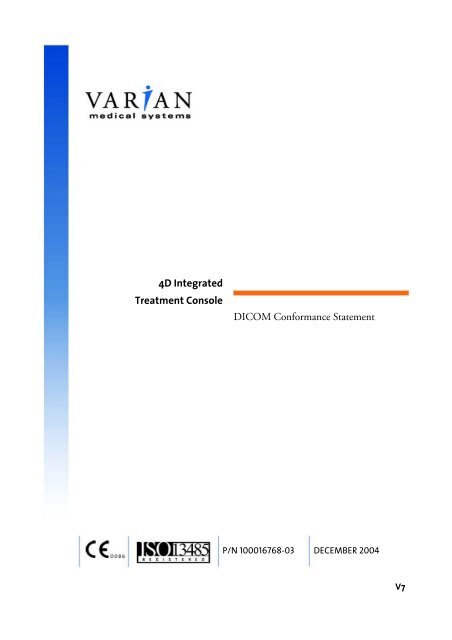



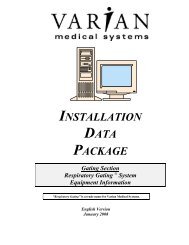
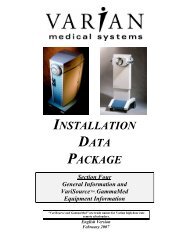
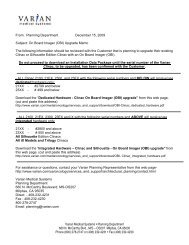
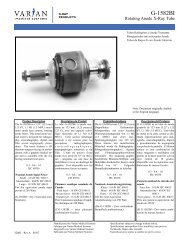
![[MSDS 126] Dow Corning 200 Fluid, 5 CST Part Number ... - Varian](https://img.yumpu.com/5104917/1/190x245/msds-126-dow-corning-200-fluid-5-cst-part-number-varian.jpg?quality=85)

